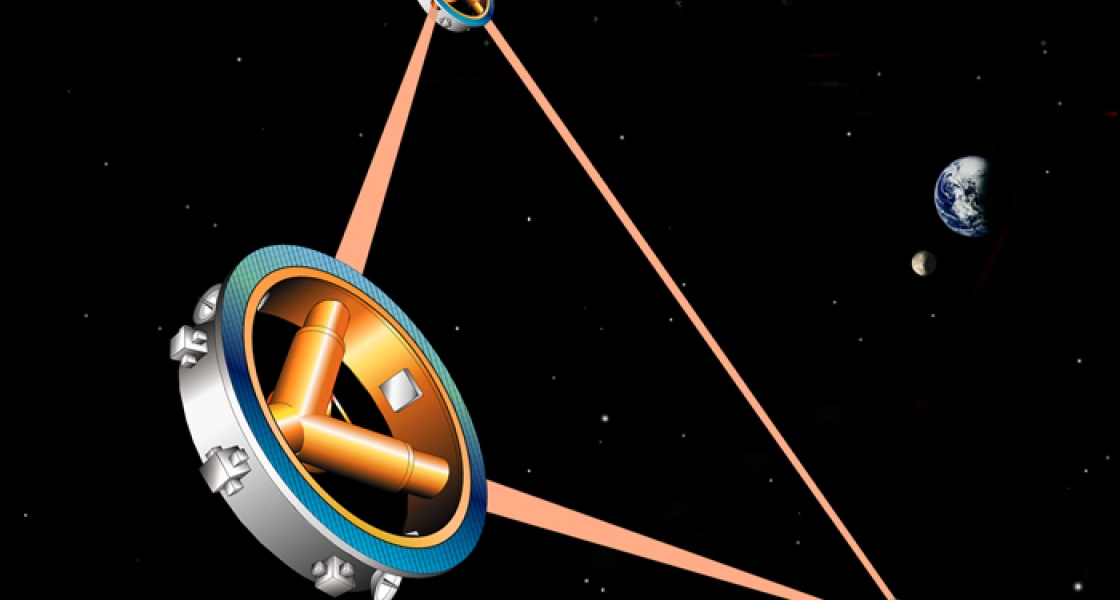When will the Laser Interferometer Space Antenna (LISA) fly? Fellows Jim Faller and Peter Bender first proposed the basic concept behind LISA more than 25 years ago. The joint European Space Agency/NASA mission first scheduled a possible launch in 2012. The date has now slipped to 2017, with additional delays possible. Both agencies are grappling with limited budgets and conflicting priorities. In the United States, plans for a future manned spaceflight to Mars are competing for funding with basic science-oriented space programs like LISA.
LISA's ambitious goal is the detailed study of gravitational waves from gigantic black hole binaries with masses up to 10 million times that of the Sun, located throughout the universe. It will observe signals from thousands of white dwarf binaries in the Milky Way and probably also from small black holes (10 solar masses) spiraling into massive black holes in distant galaxies. The existence of gravitational waves will be the last of Albert Einstein's major predictions to be directly confirmed. LISA's observations will allow scientists, including Bender and Fellow Phil Armitage, to study the formation and growth of massive black holes and the galaxies associated with them.
To detect gravitational waves, LISA will make precise laser measurements between carefully protected test masses in three spacecraft that form an equilateral triangle in orbit around the Sun, as shown at right. Each side of the triangle will be approximately 5 million kilometers long.
One challenge during LISA's mission will be to maintain the constancy of the corner angles and side lengths of the spacecraft triangle. Because the spacecraft are at different distances from the Earth at any given time, each is affected slightly differently by Earth's gravity. Over time, this will result in variations in the triangular configuration, making accurate measurement of incoming signals more difficult.
Bender recently evaluated the possibility of canceling out the differential gravitational forces on the spacecraft by continually applying tiny forces to the test masses inside each of the spacecraft. The tiny forces would be different for each spacecraft and would exactly counterbalance the differential effects of Earth's gravity. He concluded that this approach should work. The main challenge will be to ensure that the applied forces have very low noise to avoid unwanted perturbations of the test-mass separation.
Bender is now working with colleagues around the world to prepare for the LISA mission. A LISA Pathfinder mission, whose goal is to verify the (expected) extremely low level of residual test-mass accelerations, is scheduled for 2009. Then, if all goes well, LISA will lift off in 2017 to probe the secrets of massive black holes.
The research results described here have been submitted to Classical and Quantum Gravity. - Julie Phillips



 The Physics Frontiers Centers (PFC) program supports university-based centers and institutes where the collective efforts of a larger group of individuals can enable transformational advances in the most promising research areas. The program is designed to foster major breakthroughs at the intellectual frontiers of physics by providing needed resources such as combinations of talents, skills, disciplines, and/or specialized infrastructure, not usually available to individual investigators or small groups, in an environment in which the collective efforts of the larger group can be shown to be seminal to promoting significant progress in the science and the education of students. PFCs also include creative, substantive activities aimed at enhancing education, broadening participation of traditionally underrepresented groups, and outreach to the scientific community and general public.
The Physics Frontiers Centers (PFC) program supports university-based centers and institutes where the collective efforts of a larger group of individuals can enable transformational advances in the most promising research areas. The program is designed to foster major breakthroughs at the intellectual frontiers of physics by providing needed resources such as combinations of talents, skills, disciplines, and/or specialized infrastructure, not usually available to individual investigators or small groups, in an environment in which the collective efforts of the larger group can be shown to be seminal to promoting significant progress in the science and the education of students. PFCs also include creative, substantive activities aimed at enhancing education, broadening participation of traditionally underrepresented groups, and outreach to the scientific community and general public.